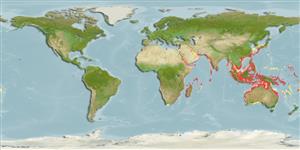Common names from other countries
>
Ovalentaria/misc (Various families in series Ovalentaria) >
Ambassidae (Asiatic glassfishes)
Etymology: Ambassis: Derived from Greek, anabasis = climbing up (Ref. 45335).
More on author: Lacepède.
Issue
Considered as a nomen dubium by Anderson & Heemstra, 2003 (Ref. 50956:200); no types known and illustration and description were found undiagnostic.
Environment: milieu / climate zone / depth range / distribution range
Sinh thái học
Biển; Nước ngọt; Thuộc về nước lợ gần đáy; pH range: 7.2 - 8.2; sống cả ở nước ngọt và nuớc mặn (Ref. 51243). Tropical; 22°C - 28°C (Ref. 12468)
Indo-West Pacific: South and East Africa, including Mauritius, Réunion, Madagascar and Seychelles, to Philippines, north to India, south to northern Australia (Ref. 33390). Extends south on African coast at least to Algoa Bay, South Africa (Ref. 4318).
Bộ gần gũi / Khối lượng (Trọng lượng) / Age
Maturity: Lm ? range ? - ? cm
Max length : 16.0 cm TL con đực/không giới tính; (Ref. 4180)
Các tia vây lưng cứng (tổng cộng) : 7 - 8; Các vây lưng mềm (tổng cộng) : 8 - 10; Tia cứng vây hậu môn: 3; Tia mềm vây hậu môn: 8 - 10.
Fairly common in marine and fresh waters (Ref. 4180); found in shallow waters; common in estuaries; may enter lower reaches of rivers. Can tolerate fresh water only within a narrow temperature (23-26°C). Feeds mainly at night on crustaceans, but also takes small fishes, fish eggs and larvae in estuaries (Ref. 7248). Marketed dried, salted and fresh (Ref.97399).
Life cycle and mating behavior
Maturities | Sự tái sinh sản | Spawnings | Egg(s) | Fecundities | Ấu trùng
Maugé, L.A., 1986. Ambassidae. p. 297-298. In J. Daget, J.-P. Gosse and D.F.E. Thys van den Audenaerde (eds.) Check-list of the freshwater fishes of Africa (CLOFFA). ISNB, Brussels; MRAC, Tervuren; and ORSTOM, Paris. Vol. 2. (Ref. 4180)
IUCN Red List Status (Ref. 130435)
CITES (Ref. 128078)
Not Evaluated
Threat to humans
Harmless
Human uses
Các nghề cá: buôn bán nhỏ; mồi: occasionally
Các công cụ
Special reports
Download XML
Các nguồn internet
Estimates based on models
Preferred temperature (Ref.
115969): 24.2 - 29.1, mean 28.1 (based on 1254 cells).
Phylogenetic diversity index (Ref.
82804): PD
50 = 0.5000 [Uniqueness, from 0.5 = low to 2.0 = high].
Bayesian length-weight: a=0.01318 (0.00743 - 0.02338), b=3.01 (2.86 - 3.16), in cm Total Length, based on LWR estimates for this species & Genus-body shape (Ref.
93245).
Mức dinh dưỡng (Ref.
69278): 3.9 ±0.56 se; based on food items.
Thích nghi nhanh (Ref.
120179): Chiêù cao, thời gian nhân đôi của chủng quần tối thiểu là dưới 15 tháng (k=1.20).
Fishing Vulnerability (Ref.
59153): Low vulnerability (12 of 100).
